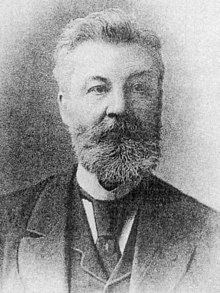John Douglas (architect)
| John Douglas | |
|---|---|

John Douglas, photograph published in 1890
|
|
| Born |
11 April 1830 Sandiway, Cheshire, England |
| Died | 23 May 1911 (aged 81) Walmoor Hill, Dee Banks, Chester, England |
| Resting place | Overleigh old cemetery, Chester |
| Residence | 6 Abbey Square, Chester 33 Dee Banks, Chester Walmoor Hill, Chester |
| Education | Articled to E. G. Paley, Lancaster |
| Occupation | Architect |
| Spouse(s) | Elizabeth Edmunds |
| Children | John Percy (1862) Colin Edmunds (1864) Mary Elizabeth (1866) Sholto Theodore (1867) Jerome (1869) |
| Parent(s) | John Douglas Mary Swindley |
John Douglas (11 April 1830 – 23 May 1911) was an English architect who designed over 500 buildings in Cheshire, North Wales, and northwest England, in particular in the estate of Eaton Hall. He was trained in Lancaster and practised throughout his career from an office in Chester. Initially he ran the practice on his own, but from 1884 until two years before his death he worked in partnerships with two of his former assistants.
Douglas's output included new churches, restoring and renovating existing churches, church furnishings, new houses and alterations to existing houses, and a variety of other buildings, including shops, banks, offices, schools, memorials and public buildings. His architectural styles were eclectic. Douglas worked during the period of the Gothic Revival, and many of his works incorporate elements of the English Gothic style. He was also influenced by architectural styles from the mainland of Europe and included elements of French, German and Dutch architecture. However he is probably best remembered for his incorporation of vernacular elements in his buildings, in particular half-timbering, influenced by the black-and-white revival in Chester. Other vernacular elements he incorporated include tile-hanging, pargeting, and the use of decorative brick in diapering and the design of tall chimney stacks. Of particular importance is Douglas's use of joinery and highly detailed wood carving.
Throughout his career he attracted commissions from wealthy landowners and industrialists, especially the Grosvenor family of Eaton Hall. Most of his works have survived, particularly his churches. The city of Chester contains a number of his structures, the most admired of which are his half-timbered black-and-white buildings and Eastgate Clock. The highest concentration of his work is found in the Eaton Hall estate and the surrounding villages of Eccleston, Aldford and Pulford.
...
Wikipedia
